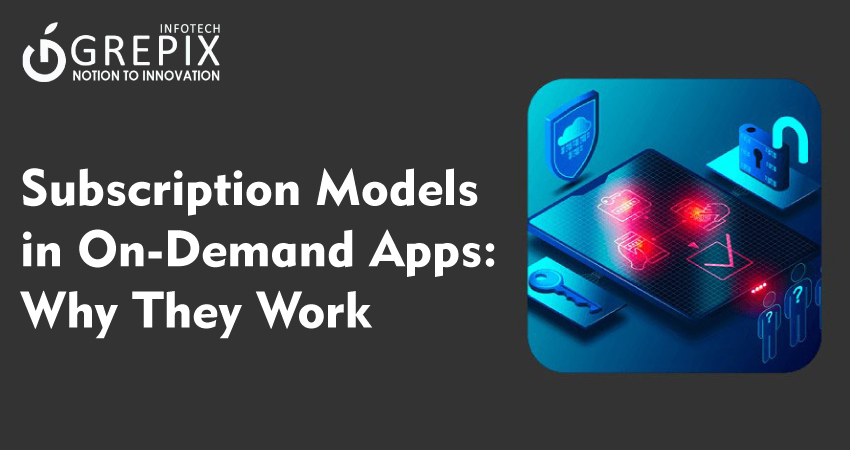Subscription Models in On-Demand Apps: Why They Work
The digital economy is experiencing a massive shift toward subscription on-demand apps. Consumers today prefer access to recurring services rather than making one-off purchases, which has given rise to the subscription economy. This trend is especially powerful in the on demand delivery app industry, where repeat usage, convenience, and loyalty play huge roles.
On demand app development companies are integrating subscription systems as the default monetization strategy. Giants like Uber, Amazon, Netflix, and even Urban Company have adopted them, proving that this business model is more than a passing trend.
Why does this shift matter? Because subscription models bring stability for businesses and tangible value for users—a win-win scenario fueling long-term growth in the on-demand marketplace.
The subscription economy has transformed how businesses and consumers interact with on-demand apps. From ride-hailing to food delivery and household services, recurring subscription-based models provide benefits for customers in terms of savings, reliability, and convenience, while ensuring predictable revenue and loyalty for businesses. Industry giants like Amazon Prime, Uber, and Netflix have paved the way, showing the power of subscription monetization. In this guide, we explore why subscription models are thriving in the on-demand delivery app space, the challenges they face, and future trends. Whether you're a startup or scaling up with an Urbanclap clone, subscriptions are the way forward.
What Are Subscription Models in On-Demand Apps?
Subscription models in apps mean users pay a recurring fee (weekly, monthly, yearly) to enjoy benefits, services, or premium access. Instead of paying per transaction, users enjoy ongoing perks.
Common Industries Adopting Subscription Models
- Ride-Hailing: Uber Pass, Lyft Pink
- Food Delivery: DoorDash DashPass, Swiggy One
- Grocery: Instacart Express, BigBasket Smart Bachat Club
- Entertainment: Netflix, Spotify
- Fitness & Wellness: Peloton, Urban Company membership
Types of Subscription Models
- Freemium: Basic access is free, premium features cost more.
- Tiered: Multiple pricing levels with varied perks (e.g., Amazon Prime Basic vs Prime Plus).
- Loyalty-Based: Rewards, cashback, or points for continued usage.
- Unlimited Access: All-you-can-use model for a fixed fee.
An Urbanclap clone integrated with subscriptions could, for instance, offer unlimited free bookings for home services within a city.
Why Subscription Models Work for Businesses
For any on demand app development company, app monetization is the ultimate challenge. Subscriptions solve this with multiple advantages:
Predictable Revenue
Monthly or annual payments create stable, recurring revenue that businesses can rely on.
Customer Loyalty
A recurring services app builds stickiness. Users who subscribe are less likely to switch to rivals, reducing churn rate.
Higher Lifetime Value
Subscriptions maximize ARPU (Average Revenue Per User), ensuring profitability isn’t limited to one-time sales.
Operational Efficiency
Recurring demand helps businesses forecast staffing, supply needs, and delivery resources more accurately.
Why Subscription Models Work for Users
Consumers stick with subscriptions because they provide lasting value over time.
Cost Savings
Discounted rates, free deliveries, bundled perks make it cheaper for frequent users.
Convenience
A one-time sign-up unlocks ongoing access without repeated payments.
Personalization
AI-driven offers, curated bundles, and tailored rewards keep experiences fresh.
Trust & Reliability
When users invest in a subscription, they feel more committed to using the service frequently.
Case Studies & Examples
Amazon Prime
Transformed retail by bundling on demand delivery app perks with entertainment streaming and exclusive discounts.
Uber Pass / Lyft Pink
Ride-hailing subscriptions providing discounted rides, priority support, and bundled benefits.
Netflix & Spotify
Subscription pioneers proving recurring content keeps users engaged for years.
Local Food Delivery Memberships
Apps like DoorDash and Swiggy offer free deliveries, showing how small players benefit too.
These examples highlight how subscription monetization works across industries. An Urban company clone could replicate this by offering repair, cleaning, beauty, and fitness services under one low monthly fee.
Challenges of Subscription Models
Despite their benefits, some hurdles exist.
Balancing Pricing vs. Value
Users must feel they’re getting more value than they spend, or they’ll cancel quickly.
Preventing Subscription Fatigue
With too many apps competing for subscriptions, businesses must innovate to stay attractive.
Continuous Innovation
Fresh features, AI personalization, and bundled add-ons are crucial to keep customer interest alive.
Also Read: "on-demand-delivery-apps-vs-traditional-business-models"
Future of Subscriptions in On-Demand Apps
The next decade of subscription on-demand apps will see exciting innovations:
Bundled Services and Super Apps
Think of a recurring services app that merges food, rides, groceries, and healthcare in one single subscription.
AI-Driven Personalization
Machine learning will adjust perks, offers, and prices to individual behavior.
Hybrid Models
Mixing pay-per-use with subscription perks for more flexible monetization.
On demand app development companies building an Urbanclap clone with hybrid models stand to dominate the evolving subscription economy.
Conclusion
Subscription models in on demand delivery apps are no longer a novelty they are the most effective path to sustainable growth and customer loyalty. By shifting to recurring payments, businesses enjoy predictable income, reduced churn, and higher user lifetime value. At the same time, customers gain convenience, cost savings, and a personalized experience.
Industry leaders like Amazon Prime, Uber, and Netflix have validated this model’s success, while on-demand app development companies are now refining clones like the Urban company clone or Urbanclap clone for startups seeking rapid market entry.
The future will likely feature bundled recurring services apps, super app ecosystems, and hyper-personalized subscription perks powered by AI. To stay competitive, businesses must embrace innovation in app monetization and deliver real value to keep subscribers engaged.
If you are planning to launch your own subscription on-demand app, now is the right time to adapt this model. Share this guide with others building the future of digital services!
FAQs
1. What is a subscription on-demand app?
A mobile application where users pay a recurring fee (monthly/annually) for continuous access to services like delivery, rides, or entertainment.
2. How do subscriptions improve app monetization?
They provide stable, predictable revenue and increase customer lifetime value compared to one-time payments.
3. Can small businesses adopt subscription models?
Yes, even small on demand delivery apps can adopt simple loyalty programs or low-cost monthly packages.
4. What challenges exist in the subscription model?
Pricing perception, subscription fatigue, and need for continuous feature updates are key challenges.
5. What is an Urban Company clone with a subscription model?
It’s a ready-made service app similar to Urban Company, integrated with subscription features for recurring revenue.







